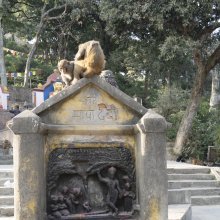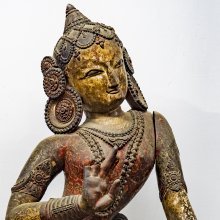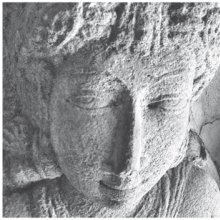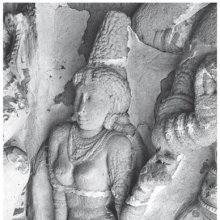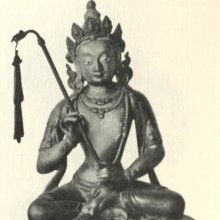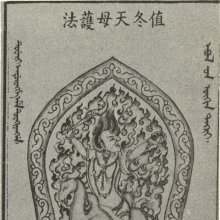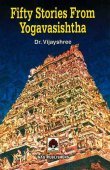Devi, Devī: 33 definitions
Introduction:
Devi means something in Buddhism, Pali, Hinduism, Sanskrit, Jainism, Prakrit, the history of ancient India, Marathi, Hindi, biology. If you want to know the exact meaning, history, etymology or English translation of this term then check out the descriptions on this page. Add your comment or reference to a book if you want to contribute to this summary article.
Images (photo gallery)
(+76 more images available)
In Hinduism
Shaktism (Shakta philosophy)
Source: Google Books: Auspicious Wisdom: The Texts and Traditions of Srividya Sakta Tantrism in South IndiaFrom the Purāṇic point of view, Devī is the sister of Viṣṇu (Harisahodarī) and the wife of Śiva (Kapāliprāṇanāyikā) and the mother of Gaṇeśa and Subrahmaṇya. Thus she is the centre of the supreme group of deities.
From the point of view of religious sādhana, the Devī who is the giver of the intuitive knowledge of God (Śivajñānapradāyinī) is herself the supreme Sādhana as shown in the Kenopaniṣad.

Shakta (शाक्त, śākta) or Shaktism (śāktism) represents a tradition of Hinduism where the Goddess (Devi) is revered and worshipped. Shakta literature includes a range of scriptures, including various Agamas and Tantras, although its roots may be traced back to the Vedas.
Natyashastra (theatrics and dramaturgy)
Source: Wisdom Library: Nāṭya-śāstra1) Devī (देवी, “lady”) refers to a specific “mode of address” (nāman) used in drama (nāṭya), according to Nāṭyaśāstra chapter 19. Devī is used by servants and attendants addressing the king’s wives. Similair terms to be used in the same situation would be Bhaṭṭini and Svāmini.
2) Devī (देवी, “queen”) refers to one of the classes of “women” (strī) who have dealings with the king, according to the Nāṭyaśāstra chapter 34. Accordingly, “those wives of the king who have all these qualities except that they are denied proper consecration, and who are proud and of royal descent, are eager for enjoying affection, are pure and always brilliantly dressed, jealous of their rivals, and maddened on account of their young age and many other qualities, are called queens (devī)”.
Source: Google Books: Music TherapyDevi has three lines on her throat representing gati, gamaka and gītam, the three grāmas of music, and from her throat emanate different types of sweet rāgas. Devi being a beautiful woman has this sign of beauty on her neck, and it represents her chastity since she has a maṅgalyasūtra of three threads by birth and by Sāmudrikaśāstra she is the pūrṇa-strī.

Natyashastra (नाट्यशास्त्र, nāṭyaśāstra) refers to both the ancient Indian tradition (shastra) of performing arts, (natya—theatrics, drama, dance, music), as well as the name of a Sanskrit work dealing with these subjects. It also teaches the rules for composing Dramatic plays (nataka), construction and performance of Theater, and Poetic works (kavya).
Ayurveda (science of life)
Nighantu (Synonyms and Characteristics of Drugs and technical terms)
Source: WorldCat: Rāj nighaṇṭu1) Devī (देवी) is another name for Mūrvā, a medicinal plant identified with Marsdenia tenacissima from the Asclepiadoideae or “milkweed family” of flowering plants, according to verse 3.19-21 of the 13th-century Raj Nighantu or Rājanighaṇṭu. The third chapter (guḍūcyādi-varga) of this book contains climbers and creepers (vīrudh). Together with the names Devī and Mūrvā, there are a total of twenty-eight Sanskrit synonyms identified for this plant.
2) Devī (देवी) is also mentioned as a synonym for Liṅginī, an unidentified medicinal plant, according to verse 3.45-47.
3) Devī (देवी) is also mentioned as a synonym for Vandhyākarkoṭakī, a medicinal plant identified with Momordica dioica (spiny gourd) from the Cucurbitaceae or “gourd family” of flowering plants, according to verse 3.61-63.
4) Devī (देवी) is also mentioned as a synonym for Śāliparṇī, a medicinal plant identified with Desmodium gangeticum (sal leaved desmodium), from the Fabaceae or “legume” family of flowering plants, according to verse 4.17-20. The fourth chapter (śatāhvādi-varga) of this book enumerates eighty varieties of small plants (pṛthu-kṣupa).
5) Devī (देवी) is also mentioned as a synonym for Ādityabhaktā, a medicinal plant, possibly identified with Helianthus annuus Linn. or “common sunflower” from the Asteraceae or “daisy” family of flowering plants, according to verse 4.179-181. Together with the names Devī and Ādityabhaktā, there are a total of eighteen Sanskrit synonyms identified for this plant.
Toxicology (Study and Treatment of poison)
Source: Shodhganga: Kasyapa Samhita—Text on Visha ChikitsaDevī (देवी) is the name of an ingredient used in the treatment of Rājilā-snake-bites, according to the Kāśyapa Saṃhitā: an ancient Sanskrit text from the Pāñcarātra tradition dealing with both Tantra and Viṣacikitsā—an important topic from Āyurveda which deals with the study of Toxicology (Viṣavidyā or Sarpavidyā).—The tenth Adhyāya prescribes antidotes for Rājilā snake venom.—According to the Kāśyapasaṃhitā verse X.12: “Nasal inhalation of Vṛṣcikālī and Munidruma mixed with urine removes Rājilā poison. Dhūpa or fumigation with Devī and feather also helps”.
Unclassified Ayurveda definitions
Source: Wisdom Library: Āyurveda and botanyDevī (देवी) is another name (synonym) for Pāṭhā, which is a Sanskrit name for the plant Cissampelos pareira (velvetleaf). This synonym was identified by Narahari in his 13th-century Rājanighaṇṭu (verses 6.119-121), which is an Ayurvedic medicinal thesaurus.

Āyurveda (आयुर्वेद, ayurveda) is a branch of Indian science dealing with medicine, herbalism, taxology, anatomy, surgery, alchemy and related topics. Traditional practice of Āyurveda in ancient India dates back to at least the first millenium BC. Literature is commonly written in Sanskrit using various poetic metres.
Purana and Itihasa (epic history)
Source: archive.org: Puranic EncyclopediaDevī (देवी).—(Mahāmāyā). Though Devī is without a beginning it is told how she became first visible to living beings. Beginning: While Mahāviṣṇu was resting on a fig leaf in the assumed form of a child he began thinking as to who he was, who created him and how he should act. And then a celestial voice announced as follows: (See full article at Story of Devī from the Puranic encyclopaedia by Vettam Mani)
Source: Cologne Digital Sanskrit Dictionaries: The Purana Index1a) Devī (देवी).—The first charioteer; a Śakti.*
- * Brahmāṇḍa-purāṇa IV. 6. 17; 20. 91.
1b) The image of.*
- * Matsya-purāṇa 258. 75; 266, 42.
1c) An Apsaras.*
- * Vāyu-purāṇa 69. 6.
Devī (देवी) or Devīpurāṇa refers to one of the eighteen Minor Puranas (i.e., Upapurāṇa) according to the Devībhāgavatapurāṇa and other traditional lists of Puranic literature: a category of ancient Sanskrit texts which gives a huge contribution in the development of Indian literature.—The Upapurāṇas (e.g., devī-purāṇa) can be considered as the supplements of the Mahāpurāṇas as those are mostly based on the Mahāpurāṇas. The Saurapurāṇa considers the Upapurāṇas as khilas i.e., supplements. [...] Though the numbers of Upapurāṇas are specified as eighteen, there are many important Upapurāṇas which are excluded from the lists of Upapurāṇas given by different sources.

The Purana (पुराण, purāṇas) refers to Sanskrit literature preserving ancient India’s vast cultural history, including historical legends, religious ceremonies, various arts and sciences. The eighteen mahapuranas total over 400,000 shlokas (metrical couplets) and date to at least several centuries BCE.
Vaishnavism (Vaishava dharma)
Source: Pure Bhakti: Bhagavad-gita (4th edition)Devī (देवी) refers to “demigoddess”. (cf. Glossary page from Śrīmad-Bhagavad-Gītā).

Vaishnava (वैष्णव, vaiṣṇava) or vaishnavism (vaiṣṇavism) represents a tradition of Hinduism worshipping Vishnu as the supreme Lord. Similar to the Shaktism and Shaivism traditions, Vaishnavism also developed as an individual movement, famous for its exposition of the dashavatara (‘ten avatars of Vishnu’).
Vedanta (school of philosophy)
Source: Shodhganga: Siva Gita A Critical StudyDevī (देवी) or Devīgītā refers to one of the sixty-four Gītās commonly referred to in Hindu scriptures.—Gītā is the name given to certain sacred writings in verse (often in the form of a dialogue) which are devoted to the exposition of particular religious and theosophical doctrines. Most of these Gītās [i.e., Devī-gītā] originate from the Mahābhārata or the various Purāṇas.

Vedanta (वेदान्त, vedānta) refers to a school of orthodox Hindu philosophy (astika), drawing its subject-matter from the Upanishads. There are a number of sub-schools of Vedanta, however all of them expound on the basic teaching of the ultimate reality (brahman) and liberation (moksha) of the individual soul (atman).
Shaivism (Shaiva philosophy)
Source: Brill: Śaivism and the Tantric TraditionsDevī (देवी) or Guhyakā refers to the “four Goddesses” of the pantheon of Mantra-deities, according to the Brahmayāmala-tantra (or Picumata), an early 7th century Śaiva text consisting of twelve-thousand verses.—Patterning the processes of inner and outer ritual is the Brahmayāmala’s pantheon of mantra-deities, whose core comprises the Four Goddesses (devī) or Guhyakās, Four Consorts or Handmaidens, and their lord, Kapālīśabhairava.
The four Dūtīs are:
- Raktā (caṃ),
- Karālī (ḍe),
- Caṇḍākṣī (kā),
- Mahocchuṣmā (pā).

Shaiva (शैव, śaiva) or Shaivism (śaivism) represents a tradition of Hinduism worshiping Shiva as the supreme being. Closely related to Shaktism, Shaiva literature includes a range of scriptures, including Tantras, while the root of this tradition may be traced back to the ancient Vedas.
In Buddhism
Theravada (major branch of Buddhism)
Source: Pali Kanon: Pali Proper NamesMother of Mahinda and Sanghamitta and wife of Asoka.
She was the daughter of Deva of Vedisagiri.
Asoka met and married her while on his way to Ujjeni, there to become Viceroy.
When he became king, Devi continued to live at Vedisagiri (Mhv.xiii.6ff; Dpv.vi.16; Sp.i.70).
She is sometimes called Vedisa devi (MT.324).
Source: Dhamma Dana: Pali English GlossaryF Female counterpart of deva (see this world).
Theravāda is a major branch of Buddhism having the the Pali canon (tipitaka) as their canonical literature, which includes the vinaya-pitaka (monastic rules), the sutta-pitaka (Buddhist sermons) and the abhidhamma-pitaka (philosophy and psychology).
Tibetan Buddhism (Vajrayana or tantric Buddhism)
Source: Wisdom Library: Tibetan BuddhismDevī (देवी) is the name of Vidyārājñī (i.e., “wisdom queen”) mentioned as attending the teachings in the 6th century Mañjuśrīmūlakalpa: one of the largest Kriyā Tantras devoted to Mañjuśrī (the Bodhisattva of wisdom) representing an encyclopedia of knowledge primarily concerned with ritualistic elements in Buddhism. The teachings in this text originate from Mañjuśrī and were taught to and by Buddha Śākyamuni in the presence of a large audience (including Devī).
Source: archive.org: The Indian Buddhist IconographyDevī (देवी) is the Śakti of Sukhendra, and together forms one of the eight Yakṣa and Śakti pairs occupying the double lotus in the sādhana of Jambhala (yab-yum form), as described in the 5th-century Sādhanamālā (a collection of sādhana texts that contain detailed instructions for rituals).—Accordingly, when represented in Yab-Yum, he sits on the moon under which there is a double lotus of eight petals. [...] The eight petals of the lotus seat are occupied by the eight Yakṣas [viz., Sukhendra], who are identical in all respects with the principal figure. Each Yakṣa is accompanied by a Śakti [viz., Devī] with whom he remains in Yab-Yum in the same way as Jambhala remains with Vasudhārā [...]. The Yakṣiṇīs are identical in form with Vasudhārā, who is yellow in complexion, carries the ears of corn and shows the Varada-mudrā in her two hands.]

Tibetan Buddhism includes schools such as Nyingma, Kadampa, Kagyu and Gelug. Their primary canon of literature is divided in two broad categories: The Kangyur, which consists of Buddha’s words, and the Tengyur, which includes commentaries from various sources. Esotericism and tantra techniques (vajrayāna) are collected indepently.
In Jainism
General definition (in Jainism)
Source: Wisdom Library: JainismDevī (देवी) is the mother of Aranātha according to Śvetāmbara (but she is named Mitrā according to Digambara), according to the Ācāradinakara (14th century work on Jain conduct written by Vardhamāna Sūri). Aranātha is the eighteenth of twenty-four Tīrthaṅkaras in Janism. A Tīrthaṅkara is an enlightened being who has conquered saṃsāra (cycle of birth and death), leaving behind him a path for others to follow.
The husband of Devī is Sudarśana. It is an ancient Jain practice to worship the Tīrthaṅkara’s parents in various rites, such as the pratiṣṭhāvidhi.
Source: archive.org: Trisastisalakapurusacaritra1) Devī (देवी) is the wife of king Sudarśana from Hāstinapura, according to chapter 6.2 [aranātha-caritra] of Hemacandra’s 11th century Triṣaṣṭiśalākāpuruṣacaritra: an ancient Sanskrit epic poem narrating the history and legends of sixty-three illustrious persons in Jainism.
Accordingly:—“Now, there is a very magnificent city, Hāstinapura, in Bhāratakṣetra in this Jambūdvīpa. [...] There Sudarśana, whose appearance was fair like the moon, was chief of kings, like Vṛtrahan of the gods. [...] His wife was named Devī, the chief-queen, like some goddess who had come, the crest-jewel of the harem. Of course, she did not show anger, even affectionately, toward her husband and, noble by nature, she did not feel jealous of her co-wives. [...]”.
2) Devī (देवी) is the daughter of Śrīmatī and Atīndra from Meghapura, according to the Jain Ramayana and chapter 7.1 [origin of the rākṣasavaṃśa and vānaravaṃśa].—Accordingly:—“[...] After innumerable lords of Rakṣodvīpa had come and gone thus, Kīrtidhavala was lord of the Rākṣasas in the congregation of Śreyāṃsa. At that time there was a renowned king of Vidyādharas, Atīndra, in the city Meghapura on Mount Vaitāḍhya. By his wife, Śrīmatī, he had a son, Śrīkaṇṭha, and a daughter, Devī, like a goddess in beauty. The Vidyādhara-lord, Puṣpottara, lord of Ratnapura, asked the fair-eyed maiden in marriage for his son Padmottara. By the decree of fate, Atīndra did not give her to him, though he was meritorious and distinguished, but he gave her to Kīrtidhavala. [...]”.

Jainism is an Indian religion of Dharma whose doctrine revolves around harmlessness (ahimsa) towards every living being. The two major branches (Digambara and Svetambara) of Jainism stimulate self-control (or, shramana, ‘self-reliance’) and spiritual development through a path of peace for the soul to progess to the ultimate goal.
India history and geography
Source: Cologne Digital Sanskrit Dictionaries: Indian Epigraphical GlossaryDevī.—(IE 8-2; CII 1, 3; LL), a title originally of wives of independent monarchs and later also of feudatory rulers; often used as a termination of the names of wives of rulers of all classes; cf. Mahādevī; also means the Mother-goddess. Note: devī is defined in the “Indian epigraphical glossary” as it can be found on ancient inscriptions commonly written in Sanskrit, Prakrit or Dravidian languages.

The history of India traces the identification of countries, villages, towns and other regions of India, as well as mythology, zoology, royal dynasties, rulers, tribes, local festivities and traditions and regional languages. Ancient India enjoyed religious freedom and encourages the path of Dharma, a concept common to Buddhism, Hinduism, and Jainism.
Biology (plants and animals)
Source: Wisdom Library: Local Names of Plants and DrugsDevi [देवी] in the Sanskrit language is the name of a plant identified with Ceropegia candelabrum subsp. tuberosa (Roxb.) H. Huber from the Apocynaceae (Oleander) family having the following synonyms: Ceropegia biflora, Ceropegia candelabrum var. biflora, Ceropegia candelabrum var. tuberosa, Ceropegia tuberosa. For the possible medicinal usage of devi, you can check this page for potential sources and references, although be aware that any some or none of the side-effects may not be mentioned here, wether they be harmful or beneficial to health.
Source: Google Books: CRC World Dictionary (Regional names)1) Devi in India is the name of a plant defined with Cissampelos pareira in various botanical sources. This page contains potential references in Ayurveda, modern medicine, and other folk traditions or local practices It has the synonym Menispermum trilobus Thunb. (among others).
2) Devi is also identified with Citrullus colocynthis It has the synonym Colocynthis vulgaris Schrad. (etc.).
3) Devi is also identified with Clematis gouriana It has the synonym Clematis vitalba var. micrantha H. Lév. & Vaniot (etc.).
4) Devi is also identified with Clematis triloba It has the synonym Clematis triloba B. Heyne.
5) Devi is also identified with Desmodium gangeticum It has the synonym Hedysarum lanceolatum Schumach. (etc.).
6) Devi is also identified with Terminalia chebula It has the synonym Myrobalanus chebula (Retz.) Gaertn. (etc.).
7) Dewi in Indonesia is the name of a plant defined with Caesalpinia coriaria.
Example references for further research on medicinal uses or toxicity (see latin names for full list):
· Annals of the Missouri Botanical Garden (1994)
· Flora Brasiliensis (1825)
· Revisio Generum Plantarum (1891)
· Observationes Botanicae (1789)
· Prodromus Stirpium in Horto ad Chapel Allerton vigentium (1796)
· Repert. Bot. Syst. (Walpers) (1842)
If you are looking for specific details regarding Devi, for example side effects, diet and recipes, chemical composition, extract dosage, health benefits, pregnancy safety, have a look at these references.

This sections includes definitions from the five kingdoms of living things: Animals, Plants, Fungi, Protists and Monera. It will include both the official binomial nomenclature (scientific names usually in Latin) as well as regional spellings and variants.
Languages of India and abroad
Pali-English dictionary
Source: BuddhaSasana: Concise Pali-English Dictionarydevī : (f.) a goddess; a queen.

Pali is the language of the Tipiṭaka, which is the sacred canon of Theravāda Buddhism and contains much of the Buddha’s speech. Closeley related to Sanskrit, both languages are used interchangeably between religions.
Marathi-English dictionary
Source: DDSA: The Molesworth Marathi and English Dictionarydēvī (देवी).—f (S) A goddess, the wife of any divine being; but used esp. of Durga or wife of Shiva. 2 pl The small pox;--it being considered as a visitation of Durga. Ex. dēvī ālyā-kāḍhalyā-kānapa- lyā-sukalya. dēvī kāḍhaṇēṃ To inoculate for the small pox. dēvī jāgaviṇēṃ To hold a wake before dēvī. A portion of a dēvīcēṃ vrata. (Amongst women.) Pr. dēvī raḍē hagatāṃ prasanna hōyagē bhaktāṃ Used in reproof of extravagant selfishness. dēvī dēvaḷānta paṇa nāyaṭē mulakānta Used where the vices or wicked doings (as of an embroiler or a slanderer) extend far and wide. Of dēvī in the sense of Small pox the varieties are āgyā -kathalyā -cighaḷyā-kōthimbiṛyā khēḷatyā- ghāgaṛyā-masuṛyā-sītaḷā-dēvī; and Inoculated small pox is kumbhārācyā dēvī or mātā. dēvīcā thāṭa The array (i. e. full or dense eruption) of the small pox.
Source: DDSA: The Aryabhusan school dictionary, Marathi-Englishdēvī (देवी).—f A goddess. pl The small-pox. dēvī kāḍhaṇēṃ Inoculate for the small-pox; vaccinate.
Marathi is an Indo-European language having over 70 million native speakers people in (predominantly) Maharashtra India. Marathi, like many other Indo-Aryan languages, evolved from early forms of Prakrit, which itself is a subset of Sanskrit, one of the most ancient languages of the world.
Sanskrit dictionary
Source: DDSA: The practical Sanskrit-English dictionaryDevī (देवी).—
1) A female deity, a goddess.
2) Name of Durgā.
3) Name of Sarasvatī.
4) Name of Sāvitrī.
5) A queen, especially a crowned queen (agramahiṣī who has undergone the consecration along with her husband); प्रेष्य- भावेन नामेयं देवीशब्दक्षमा सती । स्नायीयवस्त्रक्रियया पत्त्रोर्णं वोपयुज्यते (preṣya- bhāvena nāmeyaṃ devīśabdakṣamā satī | snāyīyavastrakriyayā pattrorṇaṃ vopayujyate) M.5.12; देवीभावं गमिता परिवारपदं कथं भजत्येषा (devībhāvaṃ gamitā parivārapadaṃ kathaṃ bhajatyeṣā) K. P.1.
6) A respectful title applied to a lady of the first rank.
7) A kind of bird (śyāmā).
8) A particular supernatural power (kuṇḍalinī).
Source: Cologne Digital Sanskrit Dictionaries: Edgerton Buddhist Hybrid Sanskrit DictionaryDevī (देवी).—name of a yakṣiṇī: Sādhanamālā 561.2 (but possibly only an epithet of one of the names which adjoin this word in a long [compound] listing names of yakṣiṇī).
Source: Cologne Digital Sanskrit Dictionaries: Shabda-Sagara Sanskrit-English DictionaryDevī (देवी).—f. (-vī) See deva .
Source: Cologne Digital Sanskrit Dictionaries: Monier-Williams Sanskrit-English Dictionary1) Devī (देवी):—[from deva] a f. See sub voce
2) Devi (देवि):—[from deva] a See devī.
3) Devī (देवी):—[from deva] b See devī.
4) Devi (देवि):—[from deva] b in [compound] for vī.
5) Devī (देवी):—[from deva] c f. (cf. deva) a female deity, goddess, [Ṛg-veda; Aitareya-brāhmaṇa; Mahābhārata] etc. (e.g. Uṣas, [Ṛg-veda vii, 75, 5]; Sarasvatī, [v, 41, 17]; Sāvitrī, the wife of Brahmā, [Mahābhārata]; Durgā, the wife of Śiva, [Mahābhārata; Harivaṃśa; Kāvya literature] etc.; the 4 goddesses of Buddhists are Rocanī, Māmakī, Pāṇḍurā and Tārā, [Dharmasaṃgraha iv])
6) [v.s. ...] Name of nymph beloved by the Sun, [cf. Lexicographers, esp. such as amarasiṃha, halāyudha, hemacandra, etc.]
7) [v.s. ...] of an Apsaras, [Mahābhārata i, 4818]
8) [v.s. ...] (with Jainas) the mother of 18th Arhat of present Ava-sarpiṇī, [cf. Lexicographers, esp. such as amarasiṃha, halāyudha, hemacandra, etc.]
9) [v.s. ...] queen, princess lady (the consecrated wife or daughter of a king, but also any woman of high rank), [Mahābhārata; Kāvya literature] etc.
10) [v.s. ...] a kind of bird (= śyāmā), [cf. Lexicographers, esp. such as amarasiṃha, halāyudha, hemacandra, etc.]
11) [v.s. ...] a [particular] supernatural power (= kuṇḍalinī), [Catalogue(s)]
12) [v.s. ...] worship, reverence, [Horace H. Wilson]
13) [v.s. ...] Name of plants (colocynth, a species of cyperus, Medicago Esculenta etc.), [cf. Lexicographers, esp. such as amarasiṃha, halāyudha, hemacandra, etc.]
14) [v.s. ...] (also) = gāyatrī, [Parāśara-smṛti]
15) [v.s. ...] = nāgī, [Buddhist literature]
Source: Cologne Digital Sanskrit Dictionaries: Yates Sanskrit-English DictionaryDevī (देवी):—(vī) 3. f. A goddess.
Source: DDSA: Paia-sadda-mahannavo; a comprehensive Prakrit Hindi dictionary (S)Devī (देवी) in the Sanskrit language is related to the Prakrit word: Devī.
Sanskrit, also spelled संस्कृतम् (saṃskṛtam), is an ancient language of India commonly seen as the grandmother of the Indo-European language family (even English!). Closely allied with Prakrit and Pali, Sanskrit is more exhaustive in both grammar and terms and has the most extensive collection of literature in the world, greatly surpassing its sister-languages Greek and Latin.
Hindi dictionary
Source: DDSA: A practical Hindi-English dictionaryDevī (देवी):—(nf) a goddess; the goddess Durga:; (deferential term for a) lady; —[dina kāṭeṃ paṃḍā paracau (paricaya) māṃgeṃ] a deity in trouble has to prove himself even to a devotee.
...
Prakrit-English dictionary
Source: DDSA: Paia-sadda-mahannavo; a comprehensive Prakrit Hindi dictionaryDevī (देवी) in the Prakrit language is related to the Sanskrit word: Devī.
Prakrit is an ancient language closely associated with both Pali and Sanskrit. Jain literature is often composed in this language or sub-dialects, such as the Agamas and their commentaries which are written in Ardhamagadhi and Maharashtri Prakrit. The earliest extant texts can be dated to as early as the 4th century BCE although core portions might be older.
Kannada-English dictionary
Source: Alar: Kannada-English corpusDēvi (ದೇವಿ):—
1) [noun] a female god or deity; a goddess.
2) [noun] Goddess Pārvati, wife of Śiva.
3) [noun] a crowned queen.
4) [noun] a mode of addressing a respectable woman.
5) [noun] an acute, highly contagious, febrile disease caused by variola virus, characterised by vomiting, and pustular eruptions that often leave pitted scars or pockmarks, when healed; smallpox.
6) [noun] the plant Trigonella corniculata of Papilionaceae family.
7) [noun] the plant Sansevieria roxburghiana of Liliaceae family; Indian bow-string hemp.
Kannada is a Dravidian language (as opposed to the Indo-European language family) mainly spoken in the southwestern region of India.
See also (Relevant definitions)
Starts with (+153): Deveshi, Devi Bhagavata Purana, Devi Vihara, Devi-ka-para, Devi-karmantika, Devi-kumara, Devibhagavata, Devibhagavatapurana, Devibhagavatasthiti, Devibhaktirasollasa, Devibhava, Devibhavana, Devibhedagiri, Devibhu, Devibhujamga, Devibhujanga, Devicakra, Devicakrapaddhati, Devichakra, Devidala.
Ends with (+280): Adhidevi, Agra-mahadevi, Agradevi, Agyadevi, Aivarkkuntevi, Ajadevi, Akasanancayata Nupaga Devi, Akkadevi, Akkatevi, Akshadevi, Amadevi, Amara Amaradevi, Amnayadevi, Anandadevi, Anangadevi, Anantadevi, Anjanadevi, Apadevi, Arvadevi, Ashtadevi.
Full-text (+2452): Lakshmi, Sinivali, Jogava, Amuktabharana, Jogina, Pattadevi, Mahakali, Krishna, Vajrashrinkhala, Devimdhiyaka, Khadgahasta, Subhaga, Shati, Dhanuhasta, Svara, Vapyatadevi, Ashvarudha, Nidra, Pashvacara, Mahavidya.
Relevant text
Search found 190 books and stories containing Devi, Devī, Dēvī, Dēvi, Dewi; (plurals include: Devis, Devīs, Dēvīs, Dēvis, Dewis). You can also click to the full overview containing English textual excerpts. Below are direct links for the most relevant articles:
Rig Veda (translation and commentary) (by H. H. Wilson)
Brihad Bhagavatamrita (commentary) (by Śrī Śrīmad Bhaktivedānta Nārāyana Gosvāmī Mahārāja)
Verse 2.1.35-37 < [Chapter 1 - Vairāgya (renunciation)]
Verse 1.3.65 < [Chapter 3 - Prapañcātīta (beyond the Material Plane)]
Verse 1.5.106 < [Chapter 5 - Priya (the beloved devotees)]
Garga Samhita (English) (by Danavir Goswami)
Verse 6.6.1 < [Chapter 6 - The Yādavas’ Victory When Śrī Rukmiṇī is Kidnapped]
Verse 6.19.41 < [Chapter 19 - In the First Fortress of Dvārakā, the Glories of Līlā-sarovara, etc.]
Verse 1.1.1 < [Chapter 1 - Description of Śrī-Kṛṣṇa’s Glories]
Bhajana-Rahasya (by Srila Bhaktivinoda Thakura Mahasaya)
Text 19 < [Chapter 5 - Pañcama-yāma-sādhana (Aparāhna-kālīya-bhajana–kṛṣṇa-āsakti)]
Text 17 < [Chapter 5 - Pañcama-yāma-sādhana (Aparāhna-kālīya-bhajana–kṛṣṇa-āsakti)]
Text 24 < [Chapter 6 - Ṣaṣṭha-yāma-sādhana (Sāyaṃ-kālīya-bhajana–bhāva)]
Puranic encyclopaedia (by Vettam Mani)
Related products
(+3 more products available)
